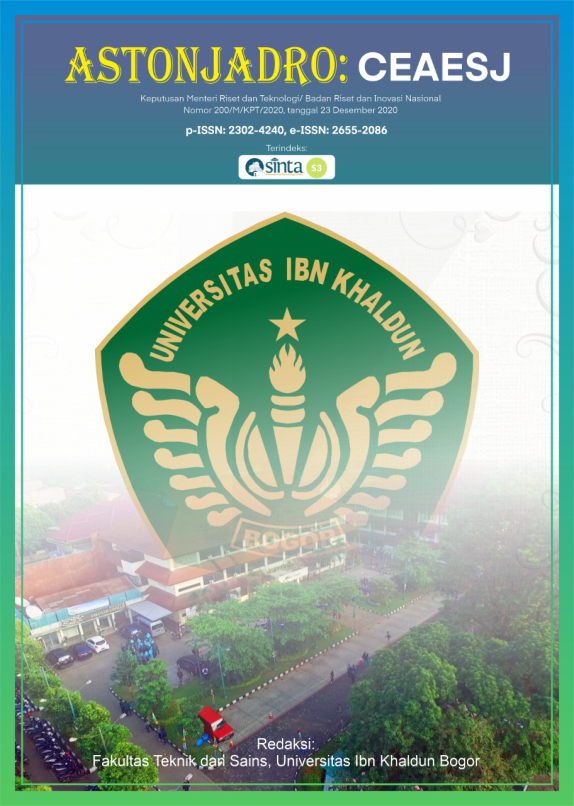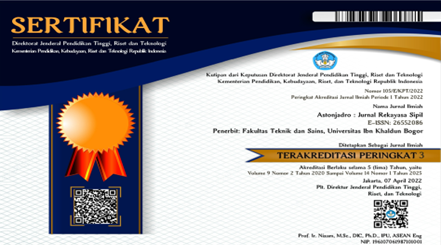TYPOLOGY OF PRIVATE CAR USERS DURING COVID-19 PANDEMIC IN KAYURINGIN JAYA
DOI:
https://doi.org/10.32832/astonjadro.v11i1.6001Keywords:
private car, typology, Covid-19, mobility, user characteristic.Abstract
The Covid-19 Pandemic was indicated in March 2020, which has changed people's daily activities patterns. Implementing the restricting regulation imposed by the government made some of the people's daily activities diverted to an online system. As a result, community mobility has decreased, especially on private car usage. However, there is a shift in vehicle usage which many people are starting to switch their mode to the private car in daily travel. This condition was predicted would continue even after the Pandemic ends. The increase in private car usage will worsen the congestion than before the Covid-19 Pandemic appropriate steps and handling are needed to prevent the increase in congestion. One of them is by knowing the characteristics and journeys of private car users during the Covid-19 Pandemic. This research is a typology of private car users during the Covid-19 Pandemic to identify the similarities and differences in the characteristics possessed by each private car user through the typological groups formed. Through this research, it can be seen the movement patterns and characteristics of the people who use private cars. This study uses the Hierarchical Cluster Analysis method. The analysis is based on several variables such as private car usage frequency variables, socioeconomic characteristics variables, demographic variables, household variables, and household travel patterns object of this research is 107 households which are owners and use of private cars for further analysis and form clusters of private car users that have the same characteristics of each cluster. The typology of private car users is compiled based on the unique characteristics possessed by each cluster that is formed. The results of this study are 8 typologies of private car users, which are divided from intensive users to irregular users. Typology 1 has the largest number of respondents and dominates the frequency of trips by private car users. The benefit of this research for the government is as input in the formulation of policies to regulate the use of private cars so that the policies taken by the government can be right on target
References
Abdullah, Muhammad., Ali, Nazam., Javid, Muhammad Ashraf., Dias, Charitha., Campisi, Tiziana. 2021. Public transport versus solo travel mode choices during the COVID-19 Pandemic: Self-reported evidence from a developing country. Transportation Engineering. Volume 5. 100078. ISSN 2666-691X. doi.org/10.1016/j.treng.2021.100078.
Atchison, C. J., Bowman, L., Vrinten, C., Redd, R., Pristerí , P., Eaton, J. W., & Ward, H. (2020). The general public's perceptions and behavioral responses during the COVID-19 Pandemic: A cross-sectional survey of UK Adults. MedRxiv. https://doi.org/10.1101/2020.04.01.20050039
Beck, M. J., & Hensher, D. A. (2020). Insights into the impact of COVID-19 on household travel and activities in Australia – The early days under restrictions. Transport Policy, 96, 76–93.doi.org/10.1016/j.tranpol.2020.07.001
Bergström, A., & Magnusson, R. (2003). Potential of transferring car trips to bicycle during winter. Transportation Research Part A: Policy and Practice, 37(8). doi.org/10.1016/S0965-8564(03)00012-0
BPS, 2020. Bekasi dalam angka 2020. (Indonesian).
Brough, R., Freedman, M., & Phillips, D. C. (2021). Understanding socioeconomic disparities in travel behavior during the COVID-19 Pandemic. Journal of Regional Science, 61(4). doi.org/10.1111/jors.12527
Cartení¬, A., di Francesco, L., & Martino, M. (2020). How mobility habits influenced the spread of the COVID-19 Pandemic: Results from the Italian case study. Science of the Total Environment, 741. doi.org/10.1016/j.scitotenv.2020.140489
Centers for Disease Control and Prevention. (n.d.). Activities, gatherings & holidays. Centers for Disease Control and Prevention. Retrieved November 8th, 2021, from www.cdc.gov/coronavirus/2019-ncov/daily-life-coping
Das, S., Boruah, A., Banerjee, A., Raoniar, R., Nama, S., & Maurya, A. K. (2021). Impact of COVID-19: A radical modal shift from public to private transport mode Transport Policy, 109, 111. doi.org/10.1016/j.tranpol.2021.05.005
Dć—delć—, A., Miškinytć—, A., Andrušaitytć—, S., & NemaniÅ«tć—-Gužienć—, J. (2020). Dependence between travel distance individual socioeconomic and health-related characteristics, and the choice of the travel mode: a cross-sectional study for Kaunas, Lithuania. Journal of Transport Geography, 86. doi.org/10.1016/j.jtrangeo.2020.102762
de Haas, M., Faber, R., & Hamersma, M. (2020). How COVID-19 and the Dutch ‘intelligent lockdown' change activities, work and travel behavior: Evidence from longitudinal data in the Netherlands. Transportation Research Interdisciplinary Perspectives, 6, 100150. doi.org/10.1016/J.TRIP.2020.100150
de Vos, J. (2020). The effect of COVID-19 and subsequent social distancing on travel behavior. Transportation Research Interdisciplinary Perspectives, 5. doi.org/10.1016/j.trip.2020.100121
Ha, J., Lee, S., & Ko, J. (2020). Unraveling the impact of travel time, cost, and transit burdens on commute mode choice for different income and age groups. Transportation Research Part A: Policy and Practice,141.doi.org/10.1016/j.tra.2020.07.020
Hancocks, S. (2020, November 27th). Survey finds motorcycle is the safest mode of transport during COVID-19. Visordown. Retrieved November 8th, 2021, from www.visordown.com/news/industry/survey-finds-motorcycles-safest-mode-transport-during-covid-19
Huang, X., Wei, F., Hu, L., Wen, L., & Chen, K. (2020). Epidemiology and clinical characteristics of COVID-19. In Archives of Iranian Medicine (Vol. 23, Issue 4). doi.org/10.34172/aim.2020.09
Firdaus, A., & Naryo. (2017, April 11th). Sehari 2 Juta Kendaraan Melintasi Bekasi. ANTARA News Megapolitan. Retrieved November 8th, 2021, fromegapolitan.antaranews.com. (Indonesian).
Ramandhika, 2012. Ramandhika, Mirza, 2012, Tipologi Ruang Interaksi Masyarakat Kawasan Permukiman Nelayan Tambak Lorok Kota Semarang, (Indonesian).
Segev, E. (2010). Google and the Digital Divide: The bias of online knowledge. In Google and the Digital Divide: The Bias of Online Knowledge. doi.org/10.1533/9781780631783
Tullis, T., & Albert, B. (2013). Measuring the User Experience: Collecting, Analyzing, and Presenting Usability Metrics: Second Edition. In Measuring the User Experience: Collecting, Analyzing, and Presenting Usability Metrics: Second Edition. doi.org/10.1016/C2011-0-00016-9
Molloy, J., Schatzmann, T., Schoeman, B., Tchervenkov, C.,
Hintermann, B., & Axhausen, K. W. (2021). Observed impacts of the Covid-19 first wave on travel behavior in Switzerland based on a large GPS panel. Transport Policy, 104. doi.org/10.1016/j.tranpol.2021.01.009
Oostendorp, R., Nieland, S., & Gebhardt, L. (2019). Developing a user typology considering unimodal and intermodal mobility behavior: a cluster analysis approach using survey data. European Transport Research Review, 11(1). doi.org/10.1186/s12544-019-0369-1
Vogel, M., Hamon, R., Lozenguez, G., Merchez, L., Abry, P., Barnier, J., Borgnat, P., Flandrin, P., Mallon, I., & Robardet, C. (2014). From bicycle sharing system movements to users: A typology of Vélo'v cyclists in Lyon based on a large-scale behavioral dataset. Journal of Transport Geography, 41, 280–291. doi.org/10.1016/j.jtrangeo.2014.07.005
Widarjono, A (2013). Ekonometrika Pengantar dan Aplikasinya disertai Panduan Eviews. Edisi Keempat. UPP STIM YKPN. Yogyakarta. (Indonesian).
Downloads
Published
How to Cite
Issue
Section
License
Copyright (c) 2021 ASTONJADRO: CEAESJ

This work is licensed under a Creative Commons Attribution-ShareAlike 4.0 International License.
Paper submitted to ASTONJADRO is the sole property of the Astonjadro Journal. Unless the author withdraws the paper because he does not want to be published in this journal. The publication rights are in the journal Astonjadro.ASTONJADRO
LICENSE
This work is licensed under a Creative Commons Attribution-ShareAlike 4.0 International License.
Based on a work at http://ejournal.uika-bogor.ac.id/index.php/ASTONJADRO













